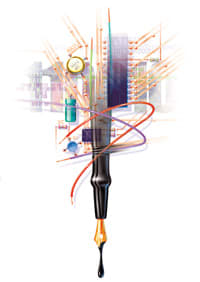the path to paperless
Choosing Network Hardware
Get the vendor and components that fit your needs.

By Peter J. Polack, M.D., F.A.C.S.
Shopping for network hardware can be like shopping for a high-definition TV. A lot of decisions must be made, and one of the toughest is choosing a brand. The natural instinct is to shop for a low price, and although price is a very important factor, other elements play a key role in the decision-making process.
Choosing a Hardware Vendor
Most large vendors negotiate pricing based not only on what you are purchasing now, but also on what you anticipate buying later, so it's important to communicate your long-term goals. Often, you can achieve better pricing on a purchase today if your vendor can count on you as a customer tomorrow.
|

|
|
|
ILLUSTRATOR: MARK HEINE/DEBORAH WOLFE, LTD |
Repair service and warranty options are critical with network hardware. Make sure you understand the service your vendor offers in your area. If they offer onsite service, how far do their techs have to drive to get to you? Do they outsource onsite service?
Tech support and product life cycle assurances are very important as well. Once you purchase a piece of network hardware, how long can you depend on such things as bios, firmware and driver support?
For our needs, we chose Dell. Dell has very competitive pricing, product life cycles longer than we keep hardware, and 4-hour onsite service for servers and switches in our area. In addition, we get discounts based on volume. The more we order from them, the more our discount increases.
Key Components
After choosing a vendor, your hardware decisions break down into three key components:
Switches. Switches are the backbone of your network and what all the cables plug into. Choosing the best switch for your office depends on how much capacity (traffic) your network needs and what media (copper cable or fiber optic) you'll use. In some cases, a network will use both copper and fiber optic, and the switches will need to be set up accordingly.
Servers. When shopping for a server, look for redundant systems. Does the server have redundant "hot swap" power supplies in case one fails? Does it have a RAID array of drives so the machine doesn't go down if a hard drive fails? How many processors does it have and how much RAM? For both processors and RAM, more is better. And make sure you get a backup device (tape drive) that is large enough to hold your data and fast enough to back up during your downtime.
Don't overlook the physical configurations of your network hardware. It might make sense to install a special rack to house the equipment, especially if you end up with multiple servers, as most EMR installations will require.
End-user devices. For EMR, are you going to use thin client terminals or actual computers? If thin clients, do you need legacy ports? Are they firmware upgradeable? Have you looked into articulated arms for the exam rooms? In our practice, we use a combination of all of the above. We keep up with changes in technology. This ensures consistent performance across the board and streamlines support.
Next: Software Issues
Peter J. Polack, M.D., F.A.C.S., is co-managing partner for Ocala Eye, PA, and a specialist in cornea, external disease and refractive surgery. Founded in 1971, Ocala Eye is a seven-partner, multisubspecialty ophthalmology practice located in Ocala, Fla. The practice, which has five locations including an ASC and laser center, has 140 employees. He can be reached by email at ppolack@ocalaeye.com.
In a multipart series, Dr. Polack is describing how a seven-partner practice, Ocala Eye in Ocala, Fla., with five locations and 120 employees, makes the major transition from paper medical records to EMR. During the course of the series, Dr. Polack will provide readers with a "real-time" look at how the implementation is progressing. This is part 7 of the series.








